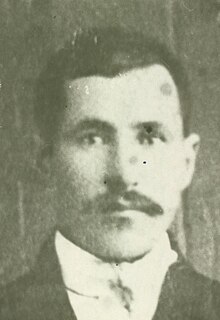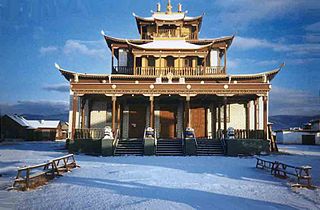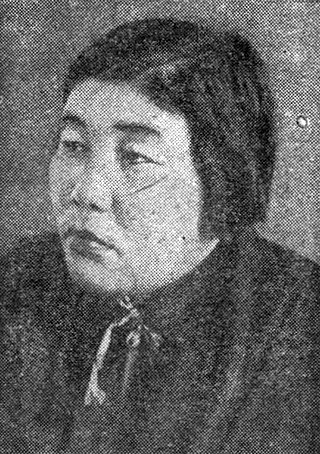Anarchism in Mongolia was present during the revolutionary period of the 1910s and 1920s, closely linked with the Russian anarchist movement in Altai, Buryatia and Tuva.
| Part of a series on |
| Anarchism |
|---|
 |
Anarchism in Mongolia was present during the revolutionary period of the 1910s and 1920s, closely linked with the Russian anarchist movement in Altai, Buryatia and Tuva.
From the 19th century onwards, Mongolia acted as a refuge for Russian and Chinese revolutionaries, fleeing persecution by their respective empires. Many anarchists were drawn there by the freedom that the wide open spaces of the sparsely-populated plateau afforded to them. [1] [2]

With the fall of the monarchy in China, the Mongolian Revolution of 1911 overthrew Qing rule, establishing the independent Bogd Khanate of Mongolia, under the rule of Bogd Khan. Tuva followed suit, declaring the independence of the Uryankhay Republic, later becoming a Russian protectorate. In 1917, the Russian Revolution overthrew the Russian Empire, establishing the Russian Republic in February. This was itself overthrown in October and the Russian Soviet Federative Socialist Republic was established in its place, igniting the Russian Civil War. In its wake, Altai and Buryatia declared independence from Russia, while Tuva was divided between Russian and Chinese occupation forces.
At the turn of 1918, anarchist detachments began to form in Siberia, including a cavalry division led by Nestor Kalandarishvil [3] and a Red Guard detachment led by Dmitri Tretyakov. In March 1918, Tretyakov's detachment attempted to establish a soviet in Kyakhta, but conflict with the local population forced them to flee to Irkutsk, where they were captured, disarmed and arrested by Centrosibir. [4] [5] [6] With the collapse of the Eastern Front and the downfall of Soviet power in Siberia, Centrosibir had ceased to function by August 1918. [7] [8] This led to many leftists, including anarchists, fleeing to Mongolia to escape the White Terror, [9] Nestor Kalandarishvili spearheaded the border crossing, [10] leading between 800 [11] and 1,500 people [12] [13] to the Mongolian village of Khatgal. They remained for a few weeks, recruiting a number of Mongols during their stay, before crossing the border back into Buryatia at Sanaga to fight a guerilla war against the Russian State. [10] [13] Anarchists, Left SRs and Maximalists also made up part of the guerilla forces of Alexander Kravchenko and Pyotr Shchetinkin, which led the re-assertion of Soviet power over Tuva in 1919. [14]
Pavel Baltakhinov, a Buryat anarchist who had been agitating against the Russian State as part of an anarcho-communist group in Irkutsk, fled from the White Terror in early 1919 and went into hiding in Mongolia. During his stay, Baltakhinov participated in anarchist agitprop among the local Mongols, such that when he returned to Siberia in August 1919, he brought many Mongols along with him, where they joined the anarchist guerillas led by Kalandarishvili. [15] He eventually came to command a Buryat guerilla detachment, [16] [17] [18] [19] made up of 50-60 people. [20]

In October 1919, the Anhui warlord Xu Shuzheng led the military occupation of Mongolia and Tuva, backed by the Empire of Japan. In February 1921, the Chinese occupation forces were ousted by the White general Roman von Ungern-Sternberg, [21] who restored Bogd Khan to the throne and led pogroms against Mongolian leftists and Jews. [22] Buryat anarchists took up the struggle against the occupation, forcing the White Army out of Mongolia. [15] In its place, the Tuvan People's Republic was established by the Tuvan People's Revolutionary Party and the Mongolian People's Republic was later established by the Mongolian People's Party, as part of a coalition between the old nobility and the new Bolshevik order, leading to early anti-government protests by many Arats. [23] Repression followed the Soviet Union's annexation of Altai and Buryatia, leading many, including the Altaian anarchist Ivan Novosyolov, to flee first to Mongolia and then to China. [24]

Nevertheless, forms of radical leftism continued to exist in Mongolia throughout the early 1920s, particularly among the "Revolutionary Union of Youth of Mongolia". It was established in August 1921 and organized for social equality, increased literacy, women's liberation, anti-clericalism and the abolition of serfdom. [25] They criticized the sluggish implementation of social reforms and refused to submit to the ruling party, noting that "much things remain as before: the princes oppress, keeping the old order, ignoring the people's situation, guided by hereditary rights and resisting the People's Government." [26] The People's Party denounced the union as anarchist rebels and the prime minister Dogsomyn Bodoo called for the implementation of extreme measures to suppress it. In response, the union armed themselves and called for the removal of government officials that opposed them, but the Buryat revolutionary Rinchingiin Elbegdorj prevented any armed confrontation from taking place. [27] The Communist International, concerned by the heterogeneous nature of the Mongolian revolutionary movement, ordered its Bolshevization. It later oversaw the formal subjugation of the Youth Union to the People's Party, further eliminating dissent to single-party rule. [28]
The Arats, who were being marginalized by the nobility and party officials, continued to push for social reforms - even managing to achieve some in Tuva. [29] However, the nobility continued to hold onto power and the feudal marginalization of Arats continued. In response, many Arats formed Chuduruk Nam, an armed anarchist militant group [30] [31] with the goal of protecting the Arats from the oppressive practices of the nobility and party officials. The organization confiscated cattle and property from the wealthy, attacked corrupt party officials, encouraged free love and promoted sanitation and hygiene. [32]
In March 1924, a counter-revolutionary insurrection was incited by the local nobility and clergy, aiming for a return to traditionalist values. [33] Supported by the Mongolian government, it demanded Tuva be annexed into the Mongolian state, [34] but the insurrection was quickly put down by the intervention of the Soviet Union, a Tuvan government detachment and squads of volunteer Arats. [35] Despite the role that Arats played in putting down the insurrection, the government blamed radical Arat activists for the situation, alleging that Chuduruk Nam had provoked it. As a result, Arat party officials were removed from their posts, including the Tuvan party chairman Oyun Kyursedi. [36] In December 1924, the Chuduruk Nam detachment was surrounded by government forces in the Ulug-Khem Valley and forcibly disarmed. [37]
With the elimination of the remaining left-wing opposition, the ruling parties of Mongolia and Tuva consolidated their power, overseen by the Communist Party of the Soviet Union. In Tuva, power fell to Donduk Kuular, a former Lama with theocratic and nationalist ambitions. In 1929, the Soviet Union orchestrated a coup d'état , which removed and executed Donduk. He was replaced with Salchak Toka, a hardline Stalinist that ruled Tuva until his death in 1972, overseeing the Soviet annexation of the country during World War II. In Mongolia, power had fallen to Peljidiin Genden, an outspoken critic of Soviet Imperialism and Joseph Stalin's anti-religious campaigns. After a public argument with Stalin, Peljidiin was removed from power by Khorloogiin Choibalsan, another hardline Stalinist. Peljidiin was subsequently executed and declared a nonperson during the Great Purge, which initiated a campaign of repression in Mongolia. The left-wing opposition remained suppressed until the Mongolian Revolution of 1990, which ended single-party rule in Mongolia.

Ulan-Ude is the capital city of Buryatia, Russia, located about 100 kilometers (62 mi) southeast of Lake Baikal on the Uda River at its confluence with the Selenga. According to the 2021 Census, 437,565 people lived in Ulan-Ude; up from 404,426 recorded in the 2010 Census, making the city the third-largest in the Russian Far East by population.

The Tuvan People's Republic (TPR), known simply as Tannu Tuva, was a partially recognized socialist republic that existed between 1921 and 1944. The former country was located in the same territory as the former Tuvan protectorate of Imperial Russia, known as Uriankhai Krai, northwest of Mongolia, and now corresponds to the Tuva Republic within the Russian Federation.

Buryatia, officially the Republic of Buryatia, is a republic of Russia located in the Russian Far East. Formerly part of the Siberian Federal District, it has been administered as part of the Far Eastern Federal District since 2018. It borders Irkutsk Oblast and Lake Baikal, the deepest lake in the world to the north, Zabaykalsky Krai to the east, Tuva to the west and Mongolia to the south. Its capital is the city of Ulan-Ude. It has an area of 351,300 square kilometers (135,600 sq mi) with a population of 978,588. It is home to the indigenous Buryats.

Buryat or Buriat, known in foreign sources as the Bargu-Buryat dialect of Mongolian, and in pre-1956 Soviet sources as Buryat-Mongolian, is a variety of the Mongolic languages spoken by the Buryats and Bargas that is classified either as a language or major dialect group of Mongolian.

Kyakhta is a town and the administrative center of Kyakhtinsky District in the Republic of Buryatia, Russia, located on the Kyakhta River near the Mongolia–Russia border. The town stands directly opposite the Mongolian border town of Altanbulag. Population: 20,041 (2010 Census); 18,391 (2002 Census); 18,307 (1989 Soviet census). From 1727 it was the border crossing for the Kyakhta trade between Russia and China.

Datsan is the term used for Buddhist university monasteries in the Tibetan tradition of Gelukpa located throughout Mongolia, Tibet and Siberia. As a rule, in a datsan there are two departments—philosophical and medical. Sometimes a department of tantric practices is added to them where the monks study only after finishing education in the philosophical department.

Buddhism in Buryatia, a region in Siberia, Russia, has a deep-rooted history dating back to the 17th century when Tibetan Buddhism first arrived in the area. Initially adopted by ethnic groups like the Selenga and Zede Buryats, Buddhism gradually spread throughout the Transbaikal region. In 1741, it gained formal recognition as an official religion in the Russian Empire, with the establishment of Buddhist monastic universities known as datsans. Despite facing significant challenges during the Soviet era, including persecution and the closure of religious institutions, Buddhism in Buryatia has persisted and experienced a revival in the post-Soviet period.

Siberian Baroque is an architectural style common for ambitious structures in 18th-century Siberia, where 115 stone churches in Siberia were recorded in 1803, most of which were built in this provincial variant of the Russian Baroque, influenced by the Ukrainian Baroque and in some cases even incorporating lamaist motifs. Most of the buildings were preserved in Irkutsk, Tobolsk and Tomsk. An original interior of a Siberian Baroque structure survives only in the Feast of the Cross Church in Irkutsk.

Damba Badmaevich Ayusheev is a Russian Buddhist monk. He is the 24th and incumbent Pandito Khambo Lama.

The Tuvan People’s Republic entered World War II on the side of the Allied Powers, shortly after the invasion of the Soviet Union by Nazi Germany that broke the non-aggression pact between the Soviet Union and Third Reich.

The Tuvan People's Revolutionary Army (TNRA) (Russian: Тувинская народно-революционная армия; Tuvan: Тываның Араттың Революстуг Шерии) was the military wing of the Tuvan People's Revolutionary Party which constituted the armed forces of the Tuvan People's Republic.
Soyot is an extinct and revitalizing Turkic language of the Siberian Sayan branch similar to the Dukhan language and closely related to the Tofa language. Two dialects/languages are spoken in Russia and Mongolia: Soyot in the Okinsky District of the Republic of Buryatia (Russia) and Tsaatan in the Darkhad valley of Mongolia.

Dorzhi Banzarov was a Buryat Orientalist and linguist. He is generally considered to be the first Buryat academic.

Bernhard Eduardovich Petri was a Russian anthropologist and archaeologist. Petri organized archeology and ethnographic expeditions to Lake Baikal, while employed by the Kunstkamera during the 1910s.
With the beginning of mobilization in Russia, anti-war and anti-mobilization protests broke out in the Russian Far East, mostly performed by women. Former Mongolian President Tsakhiagiin Elbegdorj protested against usage of ethnic minorities such as the Buryats, Tuvans, and Kalmyks as cannon fodder, and invited them to Mongolia. The Tuvans belong to Turkic peoples but are also regarded in Mongolia as one of the Uriankhai peoples.

Gunsyn Ayusheevna Tsydenova was a Soviet veterinarian and politician who served as the chairman of the Presidium of the Supreme Soviet of the Buryat-Mongol Autonomous Soviet Socialist Republic from 1941 until 1947, leading the ASSR through World War II. Tsydenova also served a deputy of the Supreme Soviet of the Soviet Union from 1937 until 1954.

Lenin–Stalinnьꞑ tugunuꞑ adaa-pile was a magazine published in Kyzyl in the Tuvan People's Republic from 1942 to 1945. It functioned as the theoretical magazine of the Central Committee of the Tuvan People's Revolutionary Party. The magazine was published in Russian- and Tuvan-language editions. Some 5,500 copies of the Russian version and some 16,000 copies of the Tuvan version were printed between 1942 and 1945.
The Buryat liberation movement is the centuries-long social and military confrontation of ethnic Buryats against the Russian Empire, which actually colonized the region. In modern history - rallies and actions against the policy of the Russian Federation.
The Buryat-Mongolian People's Party was a nationalist political party in the Russian republic of Buryatia, active from 1990 to 2001.
Buryat Genocide - repressions, ethnic cleansing, mass forced resettlement by the Russian Empire, the Soviet Union and the modern Russian Federation against the Buryat people.
{{cite book}}: CS1 maint: location missing publisher (link){{cite book}}: CS1 maint: location missing publisher (link)